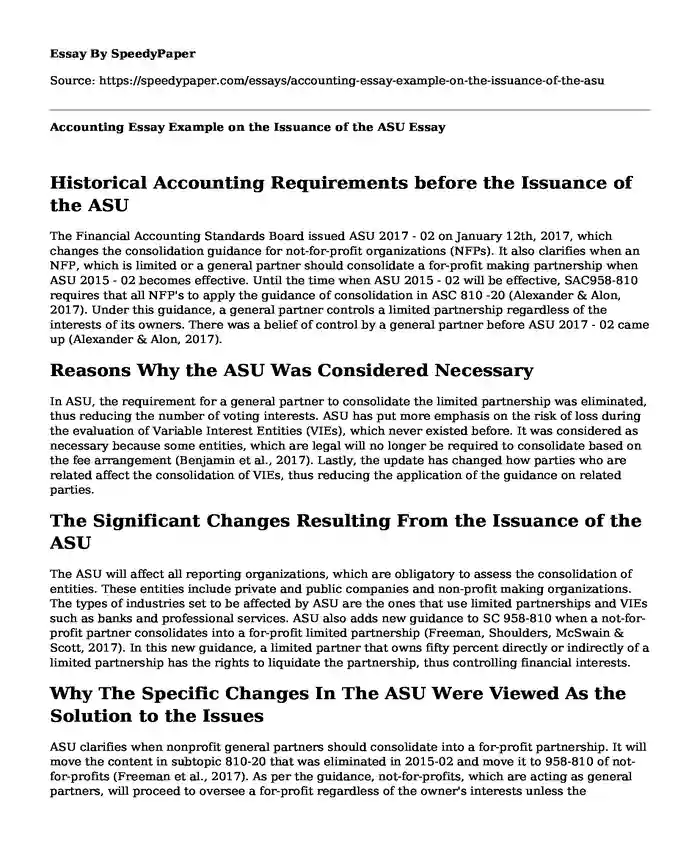
| Type of paper: | Research paper |
| Categories: | Accounting |
| Pages: | 3 |
| Wordcount: | 713 words |
Historical Accounting Requirements before the Issuance of the ASU
The Financial Accounting Standards Board issued ASU 2017 - 02 on January 12th, 2017, which changes the consolidation guidance for not-for-profit organizations (NFPs). It also clarifies when an NFP, which is limited or a general partner should consolidate a for-profit making partnership when ASU 2015 - 02 becomes effective. Until the time when ASU 2015 - 02 will be effective, SAC958-810 requires that all NFP's to apply the guidance of consolidation in ASC 810 -20 (Alexander & Alon, 2017). Under this guidance, a general partner controls a limited partnership regardless of the interests of its owners. There was a belief of control by a general partner before ASU 2017 - 02 came up (Alexander & Alon, 2017).
Reasons Why the ASU Was Considered Necessary
In ASU, the requirement for a general partner to consolidate the limited partnership was eliminated, thus reducing the number of voting interests. ASU has put more emphasis on the risk of loss during the evaluation of Variable Interest Entities (VIEs), which never existed before. It was considered as necessary because some entities, which are legal will no longer be required to consolidate based on the fee arrangement (Benjamin et al., 2017). Lastly, the update has changed how parties who are related affect the consolidation of VIEs, thus reducing the application of the guidance on related parties.
The Significant Changes Resulting From the Issuance of the ASU
The ASU will affect all reporting organizations, which are obligatory to assess the consolidation of entities. These entities include private and public companies and non-profit making organizations. The types of industries set to be affected by ASU are the ones that use limited partnerships and VIEs such as banks and professional services. ASU also adds new guidance to SC 958-810 when a not-for-profit partner consolidates into a for-profit limited partnership (Freeman, Shoulders, McSwain & Scott, 2017). In this new guidance, a limited partner that owns fifty percent directly or indirectly of a limited partnership has the rights to liquidate the partnership, thus controlling financial interests.
Why The Specific Changes In The ASU Were Viewed As the Solution to the Issues
ASU clarifies when nonprofit general partners should consolidate into a for-profit partnership. It will move the content in subtopic 810-20 that was eliminated in 2015-02 and move it to 958-810 of not-for-profits (Freeman et al., 2017). As per the guidance, not-for-profits, which are acting as general partners, will proceed to oversee a for-profit regardless of the owner's interests unless the assumption is overcame.
Comparison of the ASU to IFRS
IFRS is globally accepted standards of accounting, which are used in more than 100 countries. ASU is only applicable in the United States of America (Benjamin et al., 2017). ASU uses research and is based on specific rules while IFRS is centered on principle and overall patterns.
Other Significant Factors Considered In Developing This ASU
The first factor to be considered was the interest of stakeholders who had expressed their concerns on the existing guidelines on consolidation. There was a problem in that consolidation was not giving relevant information, which can be compared (Benjamin et al., 2017). The FASB was also interested in reducing the burden on those who prepare financial statements. Under ASU, a reporting organization is required to analyze the relationship between certain legal entities qualitatively. ASU simplified this by using a decreased number of models.
My View Regarding the Changes Arising From the Issuance of the ASU
In my view, investment companies participating in the consolidation will be adversely affected. They will be required to revise their existing documentation, which in turn, may result in consolidation or deconsolidation. Various entities should review their consolidation assessments to allocate adequate time and resources to update their documentation. This is so because consolidation assessment entails a review of investment contracts, which are not standard and aggregation of inputs, which are not tracked.
References
Alexander, D., & Alon, A. (2017). Layering of IFRS and Dual Institutionality of Accounting Standards in Belarus. Accounting In Europe, 14(3), 261-278. http://dx.doi.org/10.1080/17449480.2017.1374547
Benjamin, E. J., Blaha, M. J., Chiuve, S. E., Cushman, M., Das, S. R., Deo, R., ... & Jimenez, M. C. (2017). Heart disease and stroke statistics-2017 update: a report from the American Heart Association. Circulation, 135(10), e146-e603.
Freeman, R. J., Shoulders, C. D., McSwain, D. N., & Scott, R. B. (2017). Governmental and nonprofit accounting. Pearson.
Cite this page
Accounting Essay Example on the Issuance of the ASU. (2022, May 09). Retrieved from https://speedypaper.com/essays/accounting-essay-example-on-the-issuance-of-the-asu
Request Removal
If you are the original author of this essay and no longer wish to have it published on the SpeedyPaper website, please click below to request its removal:
- Project Management: Team Management
- Reflection Essay Sample on Cyberbullying Debate
- Essay Example on Contributions to Defined Contribution Pension Plans
- Essay Sample on Moulin de la Galette
- Essay Example Dedicated to the Migration and Its Effects in Zimbabwe
- Essay Example on Adopting Older versus Younger Children
- Essay Sample on Employee's Attitudes
Popular categories




